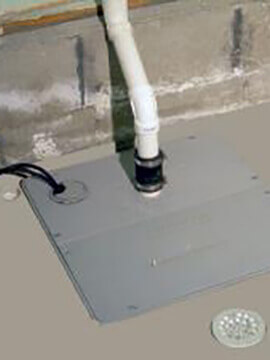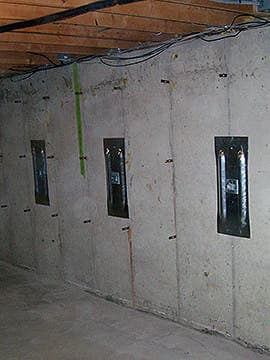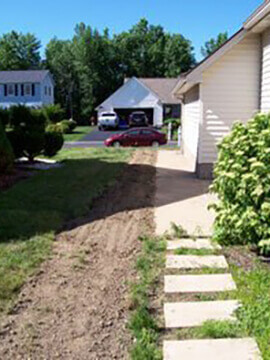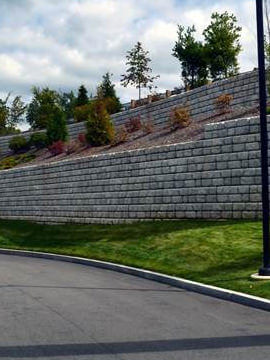Waterproofing and Yard Drainage Questions
Waterproofing: Outside Versus Inside
Many basement waterproofing companies try to sell customers on an interior and exterior system. The "exterior system" is not only a waste of money, but it is riddled with problems and concerns.
A true exterior system is the installation of a drainage system of pipe and stone, more than 2' deep (an excavator is required), and more than 5' from a foundation. This system is used to collect surface water or water moving underground via a hill or creek toward a foundation.
A foundation should NEVER be dug up by hand a foot or so down so plastic can be put on the walls.
Problems:
- If water is near the foundation in this area or coming into the basement at or near grade level, gutters, downspouts, and grading should be fixed.
- Covering the exterior wall gives a false sense of security. A gutter overflowing is not noticed and the water high up on the foundation wall is not seen because of the plastic keeping it off the foundation on the outside. Winter comes, the water freezes, pushes on the wall and a crack forms. Now the structural integrity of the foundation is compromised and thousands of dollars of foundation stabilization is needed.
Putting plastic or shallow drainage around a house is a waste of money and often causes foundation failure.
If the water is low on the wall or coming up through the trench or cracks, a new interior basement waterproofing system is needed.
If water is coming in at grade level, there is a problem outside. Gutters, downspouts, and grading need to be repaired.
If water is pooling around a foundation and gutters, downspouts, and grading have been done, then an exterior drainage system comprising of a 2'-4' deep trench with stone and piping is needed to move the water away.
We're ready to assist you with your project - give us a call or contact us online today.
Rochester: (585(-872-9077 | Buffalo: 716:839:1141
I Only See a Little Water in the Trench
A home built after the 1940's normally has 7" of stone and a 3-4" floor with a block or concrete foundation. If water is in the trench along the wall or only in the very bottom of the wall blocks, there is much more water "stuck" than what you are seeing. The water has to overwhelm the 7" of stone and have enough pressure to push up by/through the floor to be seen. Water that moves across/through the trench is only bypassing the clogged part of the system. Allowing this to occur or widening/cleaning the trench is not a fix. The problem is the clogged system under the floor. The problem will continue to worsen as the debris increases. Installing a new interior basement waterproofing system under the floor is the only way to rectify the situation.
Basement Technologies of WNY, Inc guarantees you will have no water on your floor.
Drill Holes in the Wall to Drain the Water: ie Weepholes
NEVER DRILL HOLES IN THE WALL!
If there is water in the wall, how high it is from the floor is a tell-tale sign of why it's there and what should be done to fix it.
Some customers experience dampness on the wall, some have water leaking or weeping down the wall, some have streams of water running down the wall, and some have holes that were made by the water and they're spouting water. More horrifying are the holes past homeowners have drilled that have water pouring out like a faucet.
A hole in a wall is a way for water to get in uncontrollably, leading to increase humidity to spouting water feet across the basement floor.
Water near grade level or just below almost 100% of the time has a problem with gutters, downspouts, or grading.
If the water is low on the wall, the water is "stuck" inside the wall because it cannot drain under the floor and into the stone as intended because of a failed waterproofing system.
This happens when the drain tile or french drain is clogged on the inside of the pipe and/or around outside of the pipe, keeping water in the area, and not allowing for space for the water to drain from the wall through the holes that are below floor level. They could also be compacted with minerals, efflorescent, iron ochre, silt, or other debris, but the solution is the same: a new basement waterproofing system is needed. The water needs to be removed from under the floor to allow room for the water from the walls. New weepholes will be drilled just above the footer and under the floor level so the water can be removed from the wall in a controlled manner and into the new basement waterproofing system.
If the wall is wet somewhere in the middle, be sure to check gutters, down spouts, and grading. If that doesn't rectify the problem, a new basement waterproofing system will need to be installed.
The foundation blocks could be not as hollow as other homes. They could have the same amount of water as those homes coming through the outside of the foundation, but because there is less area inside the blocks for the water to move down the core, the water pushes out as if an abundancy of water is there. In reality, the basement waterproofing system is clogged and by allowing the water to drain faster, the wall will no longer be wet.
Being an honest company and helping customers do the right thing is very important to us. If you feel this information has been helpful, please call us for an estimate. Basement Technologies of WNY, Inc (585)-872-9077.
Can I call a plumber to unclog my waterproofing system?
A basement waterproofing system is sometimes referred to as a french drain or drain tile system.
Both systems are under the floor and up against the wall with 90-degree angles at the corners. It is a gravity-fed system and the water moves through the pipes to the sump pump. If a home was built after 1920 and before ~1975, it likely has a clay drain tile system. This consists of a pipe made of clay with little holes to allow the water in. Of course this pipe is very rough, collapses easily because of the disintegration because it's clay, and clogs easily. The outside of the pipe is almost always compromised with the holes being plugged with iron ochre, mineral deposits, silt, and other things and the area around the pipe is also packed with these same things not allowing water to even get close to the pipe. If your home was built after ~1975 to today, it likely has a black corrugated pipe. This is black ribbed pipe with little square holes. The ribs allow for even greater deposits of the material listed above, clogging the pipe. The silt, iron ochre, and mineral deposits lay around the pipe as well with the non-moving water, packing tight in the stone and stopping water movement.
Both of these systems are a plumber's nightmare. The collapsed clay pipe cannot be pushed through and the snake they use to clean the inside of pipes gets caught on the degraded plastic pipe or grabs a rib spot and they can't get the snake out. We have seen them cut the snake and leave it stuck in the system.
Even if the plumber is able to clean the line, they cannot get around the 90 degree turns at the corner and cannot clean the outside of the pipe allowing the water to flow again.
Some people choose to try with a plumber first, and that's ok. If the plumber can unclog a spot, you will get some water movement again, but it is temporary. Sometimes it's enough to not see the water on the floor or dripping down the walls, but the problem hasn't been fixed. The system clogged because of the debris in it. It will happen again and the area around the pipe still has all the packed debris. Our interior basement waterproofing system are not only built to not have blockages, but also have clean out ports so general maintenance can be preformed and a snake can be used in extreme instances.
We have written, transferable guarantees that you will not have any more water on your floor. Call us today for an honest review of your basement. (585)872-9077.
3 Ways to CHEAPLY waterproof a basement
Having a dry basement is important because of mold and mildew growth, but also the disintegration of the 1st floor flooring material and other wood/organic materials in the basement. Getting rid of the water once it comes in is extremely important, but stopping water before it gets to the foundation wall, within reason, is primary. Sometimes these few simple and inexpensive things are enough to stop the water from coming in, but more importantly, it can curb very costly foundation damage.1. Gutters.
All the water from the roof should go into the gutters. Go outside and look up when it's raining. Then again when it's raining harder. What you should look for:
- Wet or black spots under gutters
- Water overflowing gutters
- Water bypassing gutters on inside corners
- Small pieces of gutter that have a large area of roof that feed to it
- Upper gutters from dormers or upper roofs that feed directly into the gutter below
- Have gutters cleaned two times per year on a schedule
- Get wider gutters
- Get gutter guards that stick up out of the gutter to force the water down
- Re-configure gutters or add more
All the water from the gutters should be discharged at least 5 feet away from the foundation.
- Downspouts that go into the ground into a storm system: Every 3-5 years, storm lines should be snaked and inspected by a plumber. Testing your gutter storm system with a garden hose cannot match Mother Nature. Call a professional. A cracked, clogged, or broken pipe can overflow water directly at the downspout connection or underground. These can be abandoned if necessary.
- Downspouts that go out on the grass: Discharge through a solid pipe a minimum of 5' away from the foundation, assuming the dirt is sloped away from the house. If the grading is off or there is a hill, the discharge has to be farther. DO NOT DISCHARGE DOWNSPOUTS INTO FLOWER BEDS! The water will lay beside the foundation causing water in the basement, or worse, foundation cracks and failure.
All dirt around a house should be 5" higher than the dirt 5' away from the house or higher. There should be a visible slope, having the water move away from the foundation. Mulch in flower beds does not count. Remove the mulch to measure where the actual dirt is. Removal of flower gardens and bushes may be necessary. Be sure to increase the grade under decks. Make sure sidewalks, driveways, and patios are "tipped" away from the foundation. Repairing grading and hard services is much cheaper compared to foundation repair AND fixing those things.
If gutters, downspouts, and grading do not fix the water coming into the basement, only a new interior system is left to be installed to stop the water. Most contractors will not tell you about these 3 very important things, but rather sell you on what they can offer you. We believe in being honest. It is important to install a new waterproofing system, but we do not take advantage of customers by NOT telling them about curbing foundation damage.
(585)-872-9077













